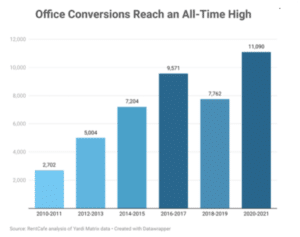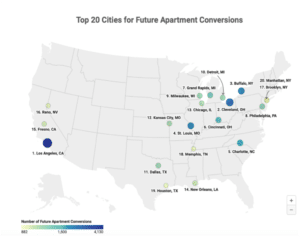Adaptive reuse in commercial real estate refers to the process of redeveloping a building or property type into a new property, typically to meet higher demand in that sector. Adaptive reuse apartments have recently become a popular subject of discussion, as US office sales continue to sink. Over the past few decades, vacant offices buildings have been redeveloped into residential buildings, offering for-sale condominiums or rental apartments.
In fact, according to market insights from RentCafé, conversions from office buildings to apartments are at an all-time high, having made way for 11,000 apartments in just the past two years. Additionally, according to data provided by RentCafé, the creation of adaptive reuse apartments is rising at a faster pace than for new apartments, up by 25% in the past 2 years compared to the pre-pandemic period.

Cities with the Highest Number of Repurposed Buildings During Pandemic
According to RentCafé, Washington, DC, Philadelphia and Chicago led the pack for the most buildings undergoing adaptive reuse since the pandemic. These top three cities are responsible for 15% of the total apartment conversions nationwide. Over the past two years, Washington DC nearly doubled its total apartment inventory by repurposing old buildings—1,565 to be exact. In fact, the district holds almost 6% of total adaptive reuse projects in the U.S. Philadelphia also maintained a strong track record of conversion projects byredeveloping older buildings into 1,552 new apartments over the past two years after a previous all-time high of 1,854 between 2018 and 2019.
Although it accounts for the highest number of total conversions over the past decade, Chicago ended up in third place with 1,139 converted apartments during the pandemic. Cleveland and Pittsburgh round out the top five, with 837 and 814 converted apartments, respectively.

The Future of Adaptive Reuse
Adaptive reuse has an exciting future ahead, based on the impressive number of conversion projects expected to be complete over the next few years. Yardi Matrix data shows a total of 77,100 future adaptive reuse apartments in various stages of conversion, a testament to the trend’s rising popularity throughout the US.
Although Los Angeles didn’t make the cut for most converted apartments during the pandemic, it’s important to note that the city is on track to complete 4,130 converted apartment units in the coming years as office demand gives way to residential demand. This alone makes 2022 the best year ever for adaptive reuse in Los Angeles.Behind LA is Cleveland, OH, with 2,654 apartments, and Buffalo, NY with 1,984 apartments.

In part 1 of our deep dive, we explored the booming trend of adaptive reuse of offices to apartments, cities with the most conversions over the pandemic and the prospects for adaptive reuse. In part 2, we will discuss the appeal of adaptive reuse for developers, and the impact it has on the environment, cost, displacement and community.




